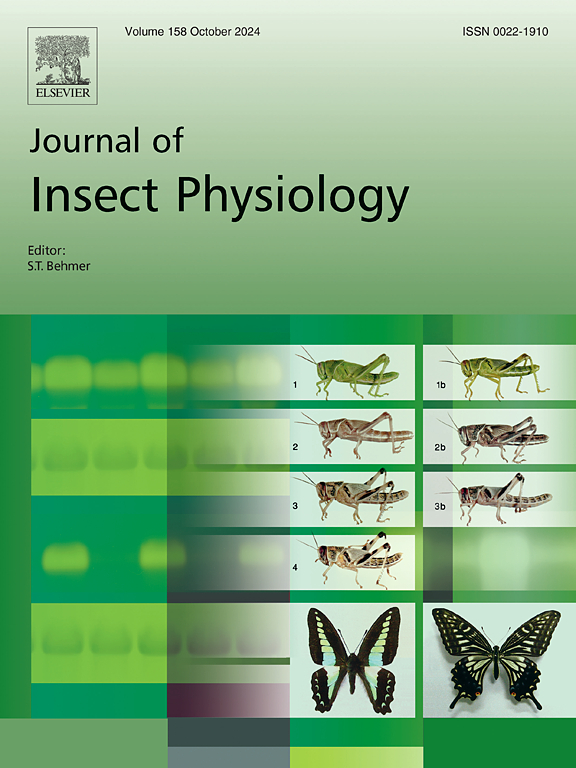豆娘黄花鸟内生产卵器的物质组成(黄花鸟科)
IF 2.3
2区 农林科学
Q1 ENTOMOLOGY
引用次数: 0
摘要
自然选择倾向于将离子(包括过渡金属)掺入易受机械断裂影响的各种生物结构材料中,以增强其失效性和耐磨性。关于昆虫,只调查了几个分类群。本研究的目的是通过纳米压痕分析豆蝇Calopteryx splendens (Harris, 1780)(齿翅目,钩翅目,豆蝇科)产卵器的生物力学特性,并利用能量色散x射线光谱确定角质层内的元素组成梯度。该研究首次报道了豆娘产卵器的角质层力学性能呈现梯度,杨氏模量约为3.0 ~ 7.0 GPa,硬度为0.1 ~ 0.3 GPa。这些性质与铜和镁的含量高度相关,两者都在远端方向增加。结果还表明,共聚焦激光扫描显微镜显示的硬化程度对角质层的力学性能有显著影响。这些发现表明,锦绣桃产卵器角质层的材料特性可能已经适应,以提高刺穿能力,并减少在植物基质中插入卵时结构失效的风险。本文章由计算机程序翻译,如有差异,请以英文原文为准。

Material composition of the endophytic ovipositor in the damselfly Calopteryx splendens (Odonata, Calopterygidae)
Natural selection has favoured the incorporation of ions, including transition metals, in materials of various biological structures susceptible to mechanical fracture to enhance their failure and wear resistance. With regards to insects, only a few taxa have been investigated. The objective of this study was to analyse the biomechanical properties of the ovipositor in the damselfly Calopteryx splendens (Harris, 1780) (Odonata, Zygoptera, Calopterygidae) through nanoindentation and to ascertain the elemental composition gradient within the cuticle using energy-dispersive X-ray spectroscopy. This research represents the first report indicating that the damselfly ovipositor exhibits a gradient in the mechanical properties of the cuticle, with Young’s modulus ranging from approximately 3.0 to 7.0 GPa and hardness from 0.1 to 0.3 GPa. These properties highly correlate with the contents of copper and magnesium, both of which increase in the distal direction. The results also suggests that the mechanical properties of the cuticle are significantly influenced by the degree of sclerotization revealed by confocal laser scanning microscopy. These findings propose that the material properties of the ovipositor cuticle in C. splendens may have adapted to enhance piercing capability and to reduce the risk of structural failure during insertion of eggs in plant substrates.
求助全文
通过发布文献求助,成功后即可免费获取论文全文。
去求助
来源期刊

Journal of insect physiology
生物-昆虫学
CiteScore
4.50
自引率
4.50%
发文量
77
审稿时长
57 days
期刊介绍:
All aspects of insect physiology are published in this journal which will also accept papers on the physiology of other arthropods, if the referees consider the work to be of general interest. The coverage includes endocrinology (in relation to moulting, reproduction and metabolism), pheromones, neurobiology (cellular, integrative and developmental), physiological pharmacology, nutrition (food selection, digestion and absorption), homeostasis, excretion, reproduction and behaviour. Papers covering functional genomics and molecular approaches to physiological problems will also be included. Communications on structure and applied entomology can be published if the subject matter has an explicit bearing on the physiology of arthropods. Review articles and novel method papers are also welcomed.
 求助内容:
求助内容: 应助结果提醒方式:
应助结果提醒方式:


